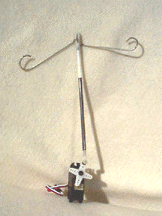
Much of this stage of the research includes determining what kinds of sensors to use in the Affective Tigger and where to put them. The goal was to include sensors that would give the Affective Tigger enough information about his environment to be able to respond to the child directly and appropriately. By observing the child when the Affective Tigger responds to a behavior, we can learn which interactions are important during play. For example during the first trial session, the Affective Tigger's bounce sensor was slightly too sensitive. The result was that he was overly happy throughout the play session. A redesign of the Affective Tigger involved physically shielding the sensor so that the child had to intentionally and forcibly `bounce' the Affective Tigger to elicit a response. This cyclical nature of testing the Affective Tigger in the hands of a child, then redesigning it according to our findings, was critical to the development of a properly responsive toy.
The important considerations in the design of the Affective Tigger's input system included: how many sensors, of what kind, and in what places. Each sensor was specifically chosen and tested for its ability to detect a narrow range of behaviors. For example the bounce switch can also be activated by spanking the Affective Tigger, thus producing an inappropriately happy response. To counter this particular effect a tilt sensor was installed that overrides the bounce detector and produces an unhappy state.
From observing children playing with stuffed animals, we noted that they sometimes pose them, like a puppet, to express an emotion. Specifically, a couple of the children in this study pushed the Affective Tigger's head down to make Tigger `look unhappy'. Leveraging off this observation, the Affective Tigger has a bend sensor in his neck that measures the droopiness of his head. When the child bends his head down, the Affective Tigger recognizes this as an `unhappy' motion. As a result the Affective Tigger puts his ears down and growls to augment the illusion of his sadness.
Children almost instinctively know that Tigger is a character that likes to bounce. Even a child who is not familiar with the Disney Tigger character will take one look at his ``rickey-tickey striped pajamas'' and understand the action of bouncing. In one case, the child became so enamored with bouncing that she began jumping all around the room to demonstrate to me that bouncing is what makes her happy too.
In the bottom of the Affective Tigger's body is a small flat lever switch surrounded by a ring of foam. This `hernia-pillow' softens the bouncing of the switch making it slightly less sensitive. When the child bounces the Affective Tigger, activating this switch, the Affective Tigger becomes happy. If he is already unhappy (see figure 3-2), say his neck is bent, he will remain unhappy. If however he is merely neutral, `bouncing' will make the Affective Tigger happy, his ears will go up and he will say ``That's what Tigger's like best!''. If the Affective Tigger is already happy, he will become VERY happy and say ``a hoo hoo hoo hoooo, wheeeee''.
A hall effect sensor detects when Tigger is turned up-side-down. Left this way for too long, the Affective Tigger becomes unhappy, then VERY unhappy, and eventually will turn off altogether.
The length of time it takes the Affective Tigger to get to the point of shutting off will vary based on his previous state (see figure 3-2). It takes 15 seconds for the Affective Tigger to progress down one mood level. Therefore, if the Affective Tigger is `happy' it takes 60 seconds of holding him upside down for him to reach the stage where he shuts off. This 15 second parameter was chosen to allow the children, with short attention spans and only half an hour to conduct the experiment, to see the changing moods of the Affective Tigger.
The post and coil accelerometer is positioned behind the Affective Tigger's eyes to detect abuse. If the child throws Tigger against a wall or drops him on the floor this sensor is activated, and the Affective Tigger immediately becomes VERY unhappy. This particular positioning also produces the side effect that if a child pokes him in the eye, he becomes VERY unhappy. These offenses are considered more severe than bending the neck, or turning upside down. As a result the Affective Tigger skips the unhappy stage and will go into shut down mode more quickly.
A string attached to a spring in the Affective Tigger's tail is attached to a switch. As the child pulls on the tail the spring is extended, eventually producing enough force to activate the switch. The tail provided the opportunity to try different reactions. When asked in a brief informal survey, five people thought pulling on Tigger's tail should elicit a happy response and four responded that it should make him unhappy. My solution was to do both, dependent on the Affective Tigger's previous `mood'. Thus, the tail pulling behavior amplified the current state of the Affective Tigger. If the Affective Tigger is happy or neutral, pulling on his tail makes him happier. If, however, he is unhappy, it will make him more unhappy. This provided a slightly more complex response, and in fact, of the twelve children in the main study, only one of them even discovered this oddity, and she didn't realize the implications.
While the Tigger character, in general, appeals to younger children, other Winnie-the-Pooh friends appeal to older children. For example, Piglet is a small quiet animal. His emotional expressions are far more subtle, and suitable for the slightly more emotionally mature child. In a hypothetical Affective Piglet doll, the duality of pulling on his tail would be far better received.
Three other features that have been left for future work are, the Affective Tigger's recognition of a kiss or squeezing on his nose, hand clap detection, and a sensitivity to the child's pulling on his whiskers.